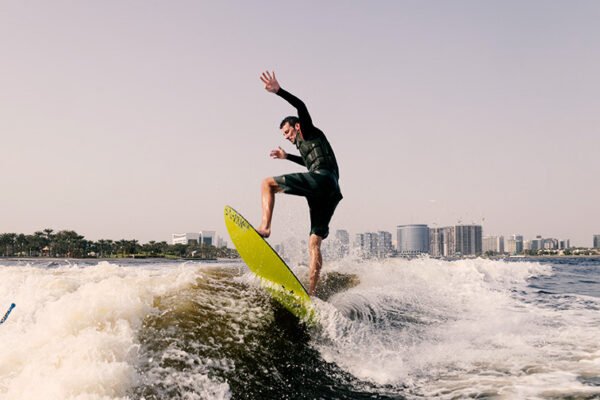
Can You Wakesurf Behind a Jet Boat? Here’s How to Set It Up
Wakesurfing has rapidly become one of the most popular water sports, offering a thrilling experience where surfers ride the wave created by the boat. Traditionally, wakesurfing is done behind inboard boats designed for creating the perfect surfable wake. But what about jet boats? Can you wakesurf behind a jet boat? The answer is yes—with the right setup and safety measures, you can enjoy an epic wakesurfing session behind a jet boat. Here’s everything you need to know to set it up properly.
Why Wakesurf Behind a Jet Boat is Possible
A common misconception is that jet boats cannot create a surfable wake. While jet boats have different propulsion systems compared to traditional wake boats (using jet propulsion rather than a propeller), with the right conditions and tweaks, jet boats are capable of generating wakes that can be surfed.
Safety Considerations for Wakesurf Behind a Jet Boat
Before diving into the setup, it’s essential to address safety. Jet boats use water jets for propulsion, which eliminates the risk of injury from exposed propellers, making them safer for wakesurfing. However, jet boats typically produce smaller wakes, so the key is in optimizing your setup to enhance the wave size and shape.
Key Safety Tips:
- Stay Close to the Boat’s Centerline – Jet boats have flatter wakes, so stay directly behind the boat.
- Use a Tow Rope Designed for Wakesurfing – Always use the right equipment, especially when starting your surf behind a jet boat.
- Proper Positioning – Always make sure to position yourself at the safest distance from the jet boat’s water jets to avoid unnecessary risks.
How to Set Up a Jet Boat for Wakesurf
To wakesurf behind a jet boat, you’ll need to make a few adjustments to the boat’s ballast and weight distribution. Here are some steps to follow to create the best possible wake.
1. Add Ballast to Create a Bigger Wake
Ballast is crucial for wakesurfing as it adds weight to the boat, helping displace water and create a larger, more surfable wake. Jet boats typically come without built-in ballast systems, but you can easily add portable ballast bags.
Steps for Ballast Setup:
- Place Ballast in the Back – The majority of the ballast should be added to the stern (rear) of the boat. This helps increase the wake’s height.
- Evenly Distribute Ballast – Make sure the ballast is evenly distributed on the side of the boat where the surfer will be riding. This helps to create a wave with more shape and push.
- Experiment with Weight – Adjust the amount of ballast depending on the number of people on board and the desired wave size. More weight generally creates a larger wake.
2. Trim Tabs and Wake Shapers
Trim tabs and wake shapers are additional tools that can improve the wake shape behind a jet boat.
- Trim Tabs: These devices help shape the wake by adjusting the boat’s angle in the water. You can lower the tabs on one side to tilt the boat and enhance the surfable wave on the opposite side.
- Wake Shapers: These attach to the side of the boat and redirect the water flow to create a more defined and cleaner surf wave. For jet boats, wake shapers can be an excellent addition to improve the overall wave size and shape for wakesurfing.
3. Speed Optimization
Speed is another important factor when wakesurfing behind a jet boat. Jet boats may require a slightly different approach to speed compared to traditional wake boats.
- Ideal Speed: The sweet spot for wakesurfing behind a jet boat is usually between 9-12 mph. Too slow, and the wake won’t have enough push; too fast, and the wave becomes too flat.
- Fine-Tune the Speed: Jet boats often have speed controls or throttles that allow you to fine-tune the speed for optimal wake creation. Be sure to test and adjust speed settings based on your ballast setup and water conditions.
4. Passenger Placement
Passenger placement can make a significant difference in shaping the wake. The more weight you place toward the rear and on the side where the surfer will be riding, the better the wave shape.
- Concentrate Weight on the Surf Side: Ask your passengers to sit on the same side of the boat where you plan to wakesurf. This shifts the boat’s weight to one side, helping create a cleaner wave with more push.
- Balance the Load: If you want to switch sides for the surfer, reposition passengers to keep the weight distribution optimal for surfing.
5. Choosing the Right Board for Wakesurfing Behind a Jet Boat
Choosing the right wakesurf board can make a significant difference, especially when surfing behind a jet boat with smaller wakes.
- Surf-Style Boards: These boards are larger and have more buoyancy, making it easier to ride smaller, less powerful waves. They are ideal for beginners and for use behind jet boats.
- Skim-Style Boards: These boards are smaller and more maneuverable, ideal for advanced surfers who want to perform tricks. However, they may not be the best choice if your jet boat struggles to create a large wake.
Final Thoughts on Wakesurfing Behind a Jet Boat
Wakesurfing behind a jet boat is entirely possible and can be a thrilling experience with the right setup. By adding ballast, using trim tabs and wake shapers, optimizing speed, and positioning passengers correctly, you can create a surfable wave behind your jet boat. Always prioritize safety, and be sure to use the right equipment, such as wakesurf boards designed for smaller wakes.
With a few adjustments, your wakesurf session behind a jet boat can rival that of a traditional wake boat, offering endless fun on the water.


